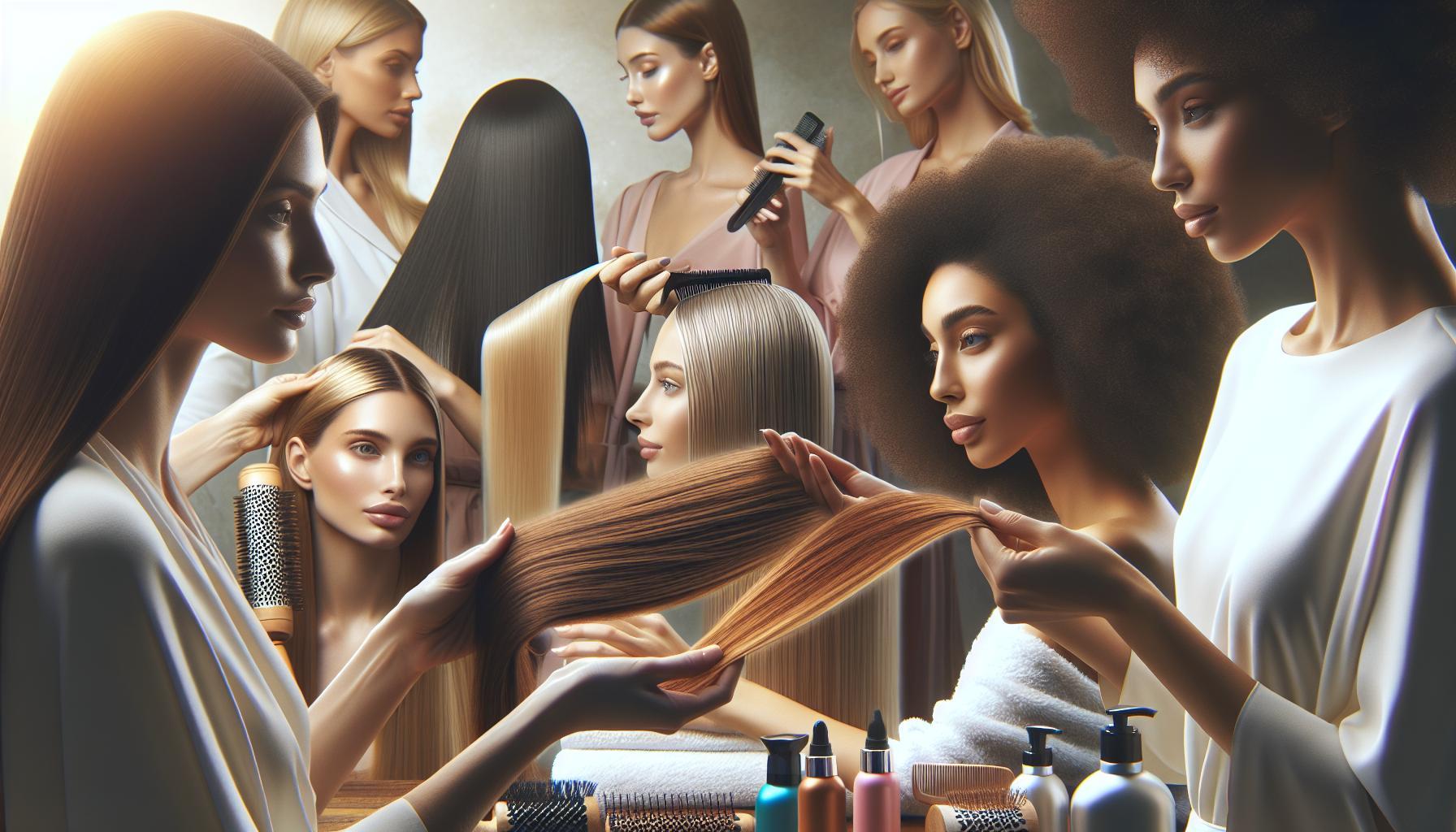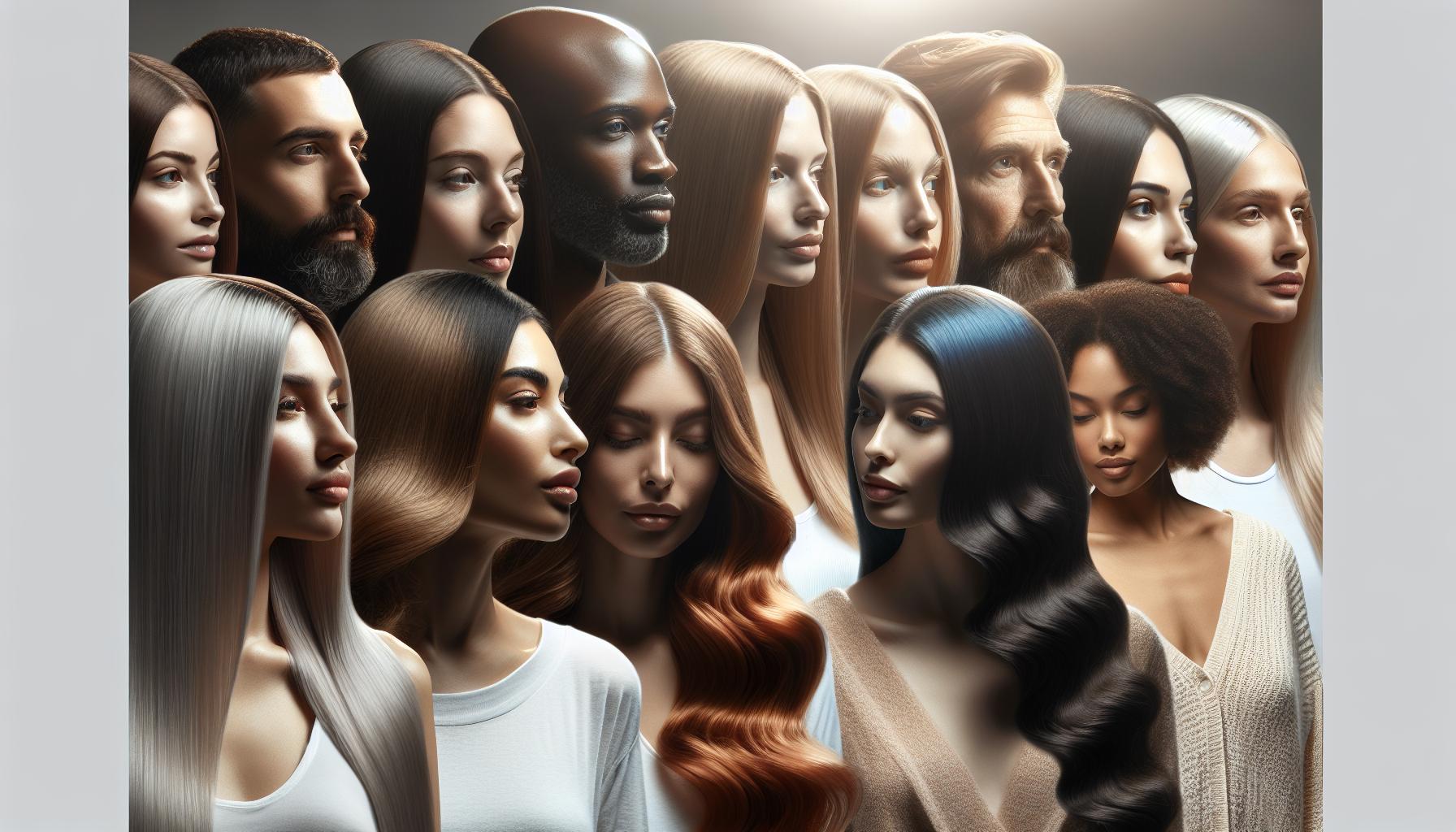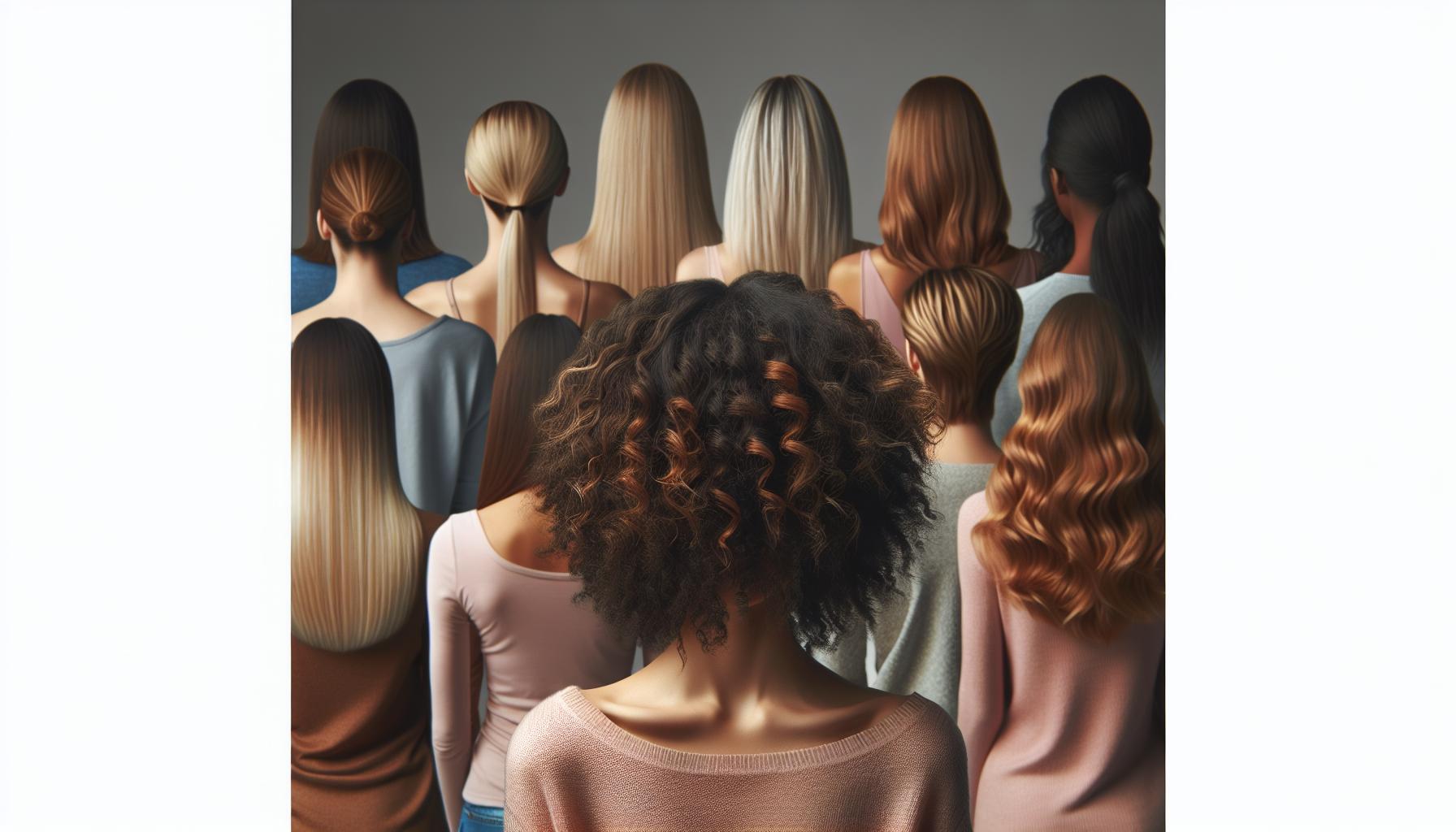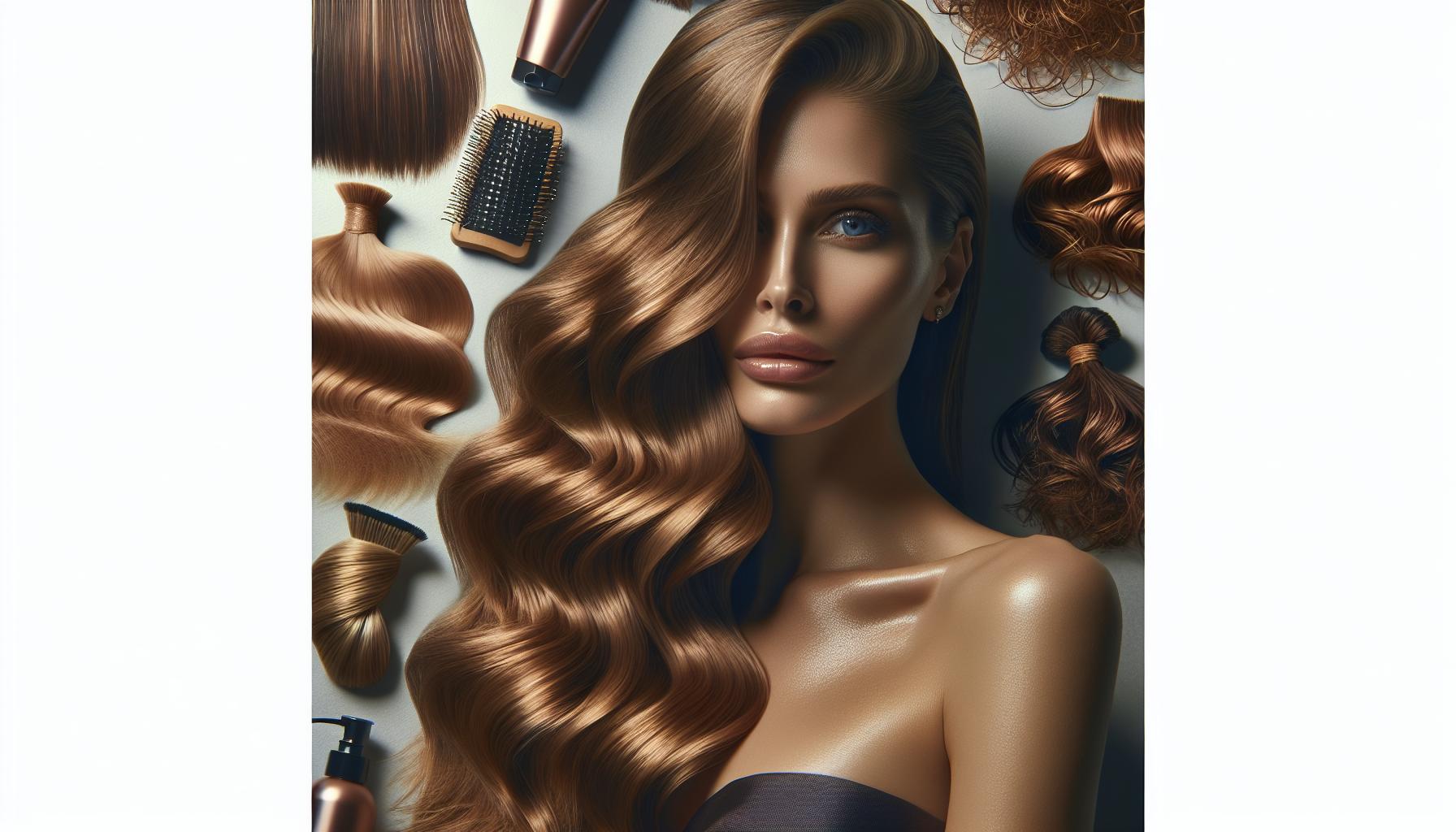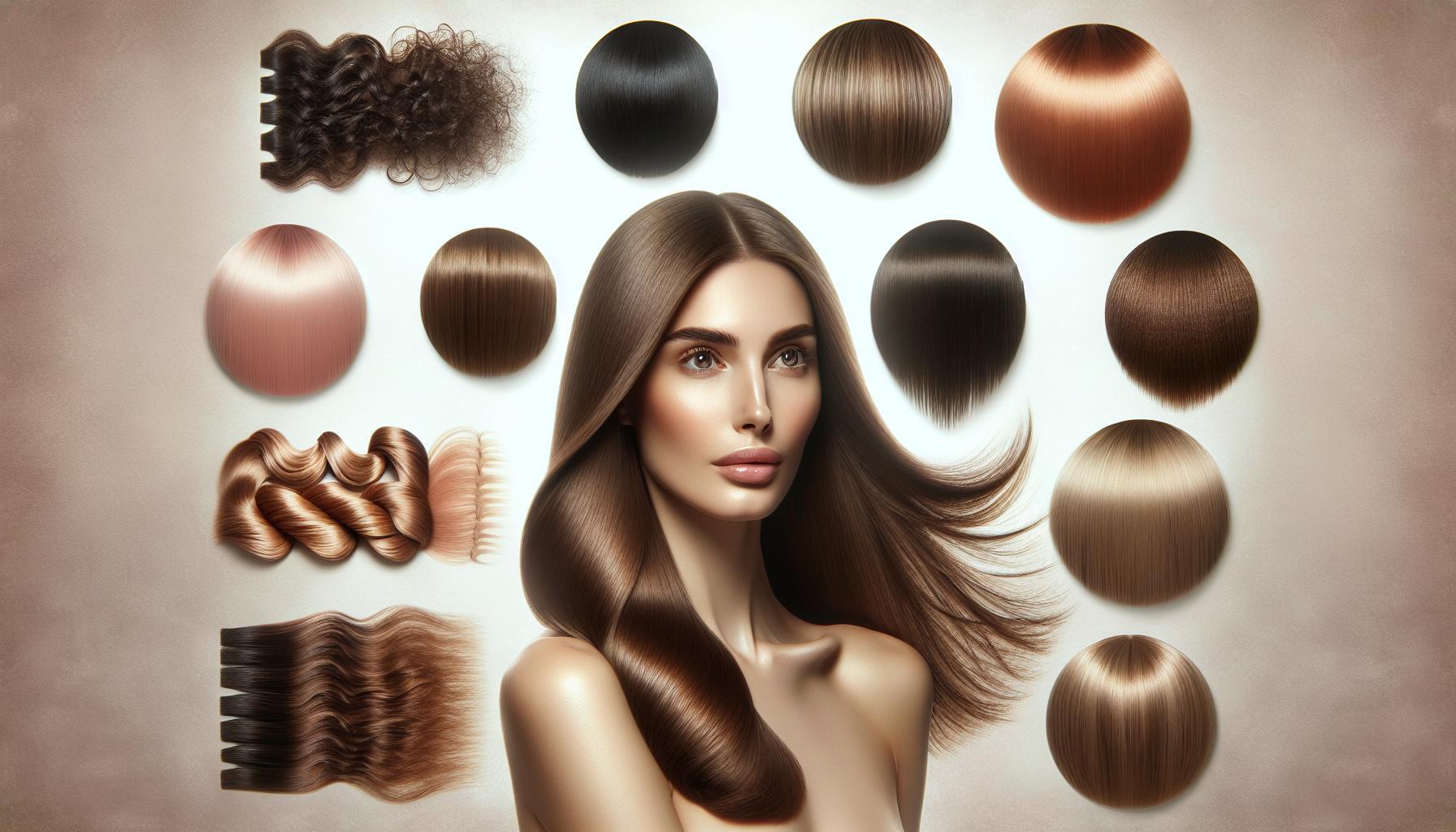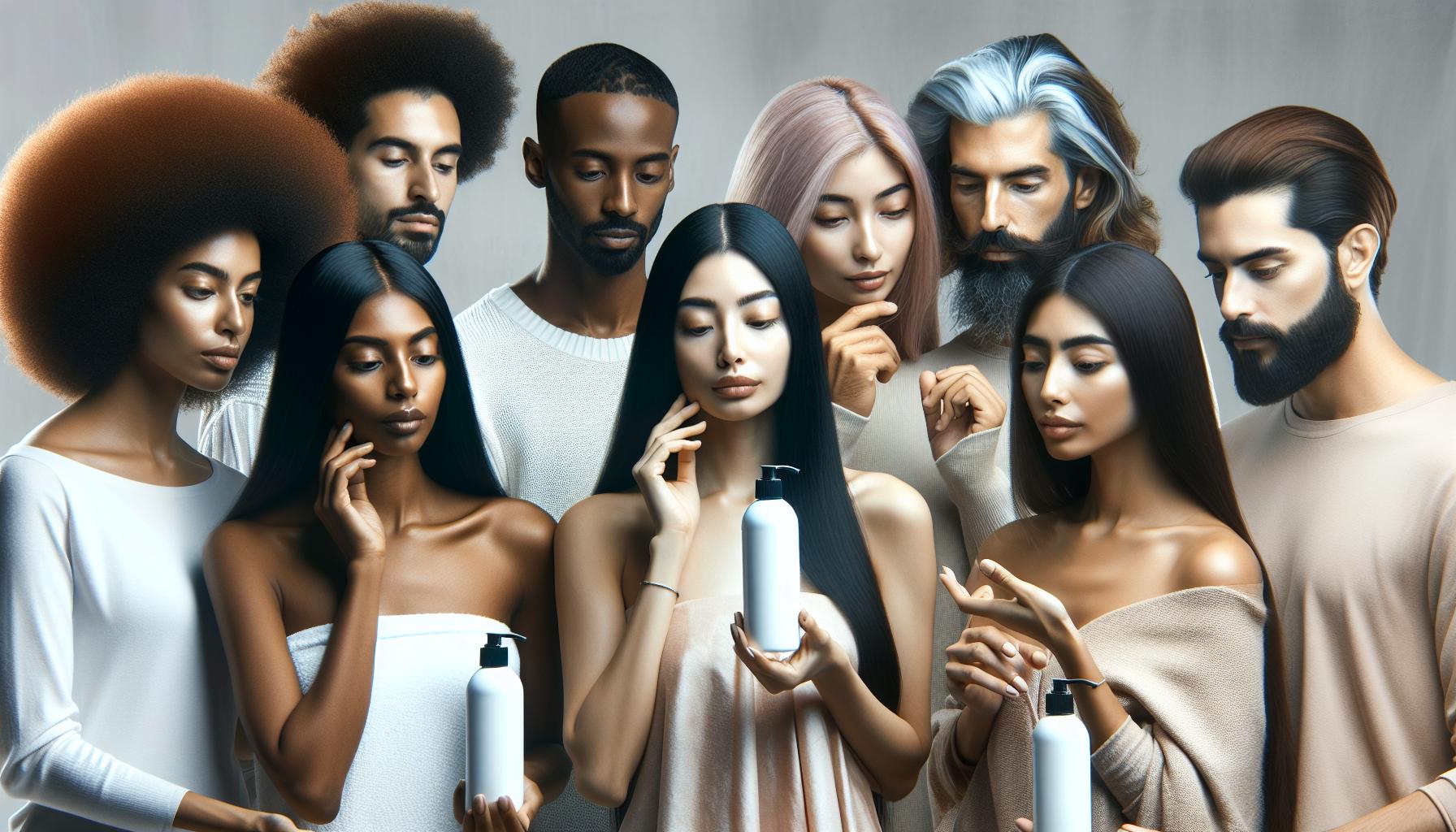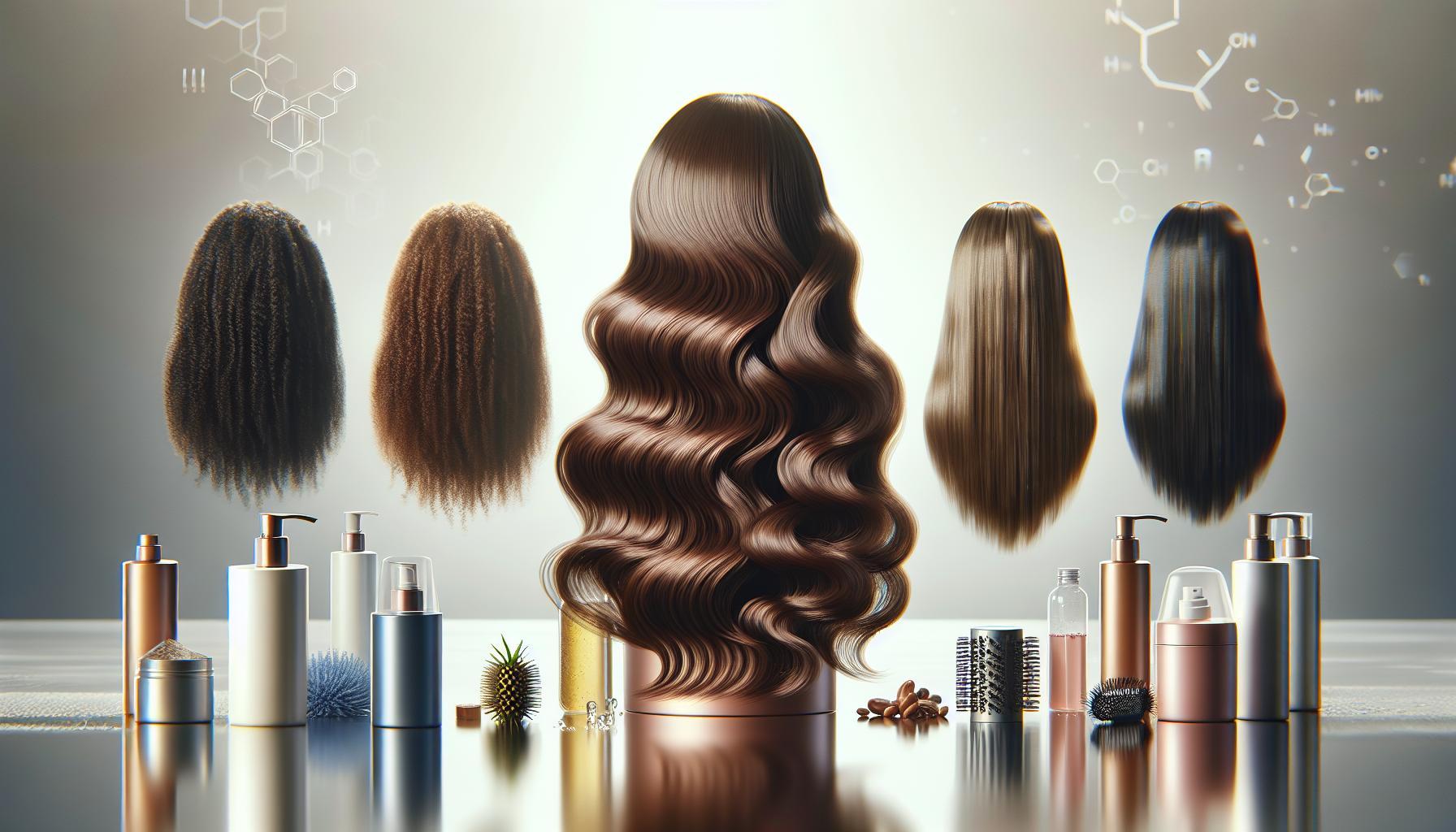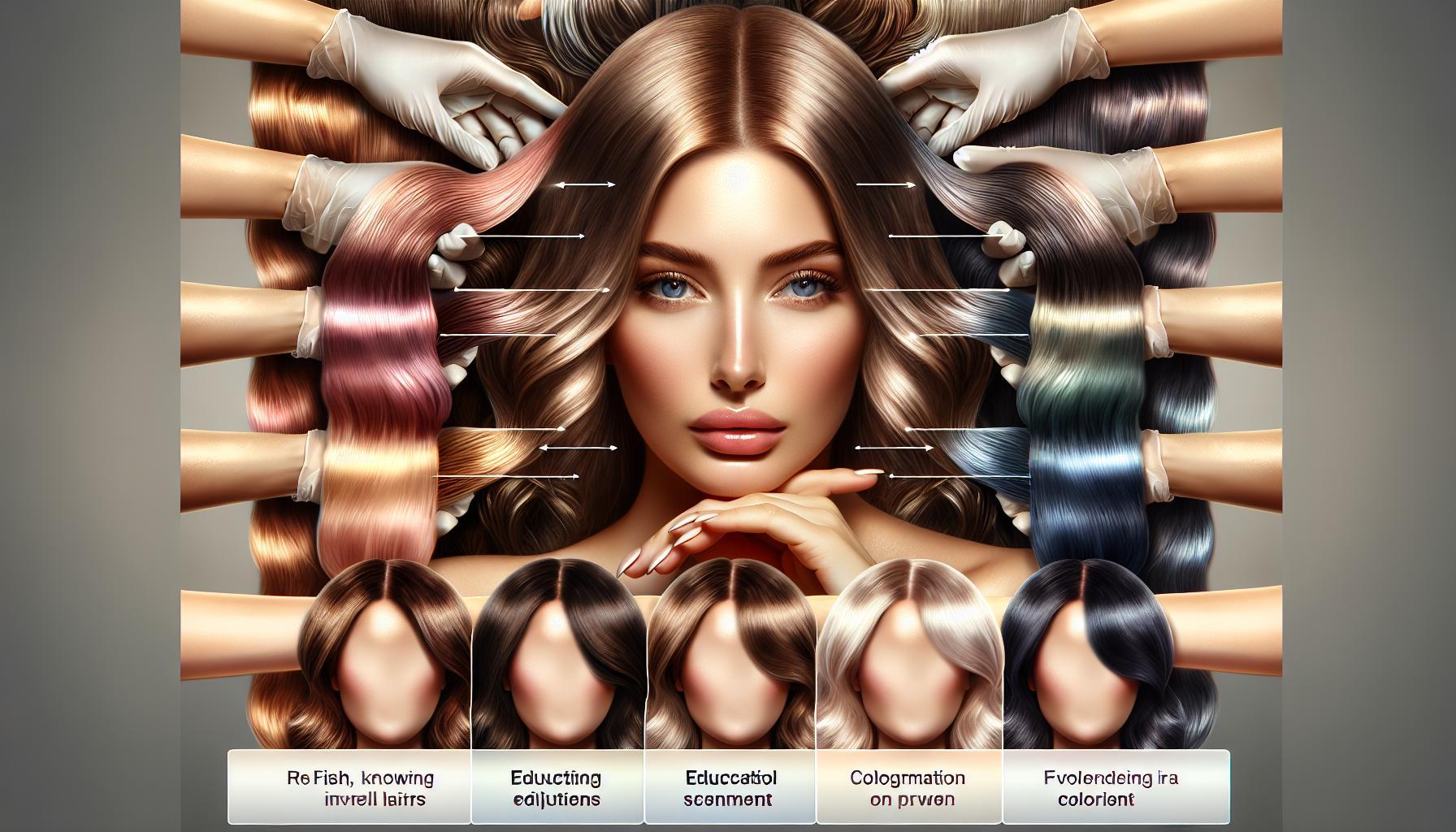Are you feeling disappointed with your new hair color? Whether it turned out too dark, too brassy, or simply not what you envisioned, you’re not alone. Addressing hair color mishaps is crucial for client satisfaction, and this article will explore effective solutions and professional salon tips that can restore your hair’s vibrancy and your confidence.
Contents
- Understanding the Causes of Hair Color Disappointment
- Common Mistakes in Color Application and How to Avoid Them
- Quick Fixes for Unwanted Hair Color Dramas
- Salon Solutions: When to Seek Professional Help
- The Importance of Communication: Discussing Your Hair Goals
- Home Remedies to Adjust or Tone Down Hair Color
- Managing Expectations: The Reality of Hair Color Changes
- Preventing Future Hair Color Frustrations: Tips from Experts
- Faq
- A customer not happy with hair color? What should I do first?
- Why does a customer feel unhappy with their hair color?
- Can I fix hair color at home if I’m not happy?
- What salon solutions exist for unhappy customers?
- How can communication improve hair color results?
- What can a customer expect during a color correction appointment?
- Why is aftercare critically important for hair color?
- to Wrap It Up
Understanding the Causes of Hair Color Disappointment
Feeling underwhelmed after a trip to the salon can be disheartening,notably when it comes to something as personal as hair color. The quest for the perfect hue can often lead to unexpected results, leaving customers puzzled and dissatisfied. Understanding the underlying causes of these hair color disappointments can empower clients and hair professionals to navigate the complex world of hair dye more effectively.
Color Miscommunication
One of the primary reasons for dissatisfaction stems from a breakdown in interaction between the client and stylist. misunderstandings can arise when discussing desired outcomes, often leading to mismatched expectations. To prevent this, it’s essential for both parties to be on the same page.Here are a few strategies that can enhance clarity:
- Bring References: Clients should bring photos of the desired hair color, while stylists can share color swatches or charts to illustrate potential outcomes.
- Discuss Hair History: Be upfront about previous hair treatments, as this can considerably influence the final result.
- Ask Questions: Encourage clients to ask for clarification on techniques or products that will be used.
Chemical reactions and Hair Health
Another common issue originates from the physical condition of the hair and how it reacts to color treatments. Poor hair health can disrupt the dyeing process, leading to faded or uneven colors. Various factors can impact how hair absorbs dye, including:
| Factor | Description |
|---|---|
| Previous Color Treatments | Hair that has been previously dyed or chemically treated may not absorb new colors as expected. |
| Hair Texture | Curly or coarse hair may require different formulations compared to straight hair. |
| Environmental Factors | Sun exposure and pollution can also affect hair color vibrancy. |
Understanding these elements can definitely help both customers and stylists make informed decisions regarding which treatments to apply and how to maintain healthy hair before and after coloring.
With a clearer grasp of these foundational issues surrounding hair color dissatisfaction, clients can approach their next salon visit with realistic expectations and knowledge, paving the way for a more fulfilling experience in their quest for beautiful hair.
Common Mistakes in Color Application and How to Avoid Them
understanding color application in hair design can be intricate, and even seasoned professionals can stumble into pitfalls that leave customers dissatisfied. Research indicates that nearly 30% of clients express dissatisfaction with their hair color, a statistic that underscores the importance of precision and skill in color application. Recognizing common mistakes made during this process—and knowing how to avoid them—can definitely help salons maintain their reputation and ensure customer satisfaction.
Common Mistakes to avoid
One of the most prevalent errors involves mismatching the client’s desired shade with their natural hair color.This scenario often arises when stylists don’t take into account the underlying pigments in the hair. Such as, a client requests a vibrant cherry red but has dark brown hair, which may lead to a muted result unless the base is pre-lightened adequately.
- Tip: Always conduct a thorough consultation and a strand test.
- Tip: Consider the client’s hair history,including previous colors and treatments.
Another common mistake is the uneven application of color, resulting in patchy or streaky hair. this can happen during self-application at home or even in a salon setting if the stylist rushes through the process. Uneven processing times between sections of hair can also cause discrepancies in color.
How to Prevent Uneven Application
To avoid these complications,stylists should implement systematic methods,such as:
- Sectioning the Hair: Divide hair into manageable sections to ensure even coverage.
- Using the Right Tools: Employ applicator brushes for precision rather than relying solely on bottles.
- Timing is key: Use a timer to guarantee consistency in growth across all sections.
Lastly, employing the wrong developer strength is a misstep that frequently occurs but can be easily rectified. For instance, using a 10-volume developer on hair requiring a 20-volume can lead to lackluster results.
| Use Case | Recommended Developer |
|---|---|
| Covering Gray Hair | 20 Volume |
| Going One or Two Shades Lighter | 20 Volume |
| Lightening Hair More than Two Shades | 30 or 40 Volume |
Ensuring clarity during consultations, applying color uniformly, and selecting the appropriate developer can dramatically reduce the chances of a customer leaving the salon unhappy with their hair color. By focusing on these practical steps and learning from common mistakes in color application, stylists can consistently achieve outstanding results and maintain a loyal clientele.
Quick Fixes for Unwanted Hair Color Dramas
Sometimes,despite our best efforts,the hair color results can fall short of expectations. Whether it’s a shade that turned out too dark,too light,or simply not the desired hue,clients often walk out of the salon feeling disappointed. These scenarios are not uncommon—many people have experienced moments where vibrant reds turned muddy, blondes came out brassy, or ash tones looked unexpectedly warm. Though, quick solutions are at hand to correct these unwanted hair color dramas and send those unhappy customers home with a smile.
understanding the Problem
To tackle hair color mishaps effectively, it’s crucial to identify the underlying issue. Here are some common scenarios that might lead to an unhappy outcome:
- Color Too Dark: This frequently enough happens due to the hair absorbing more pigment than expected.
- Brassy Undertones: Warmer tones can emerge especially in blonde and highlighted hair if not processed correctly.
- Uneven Application: When the dye isn’t applied evenly, patches of color can occur, leaving the hair looking unbalanced.
- Incorrect Shade Selection: Sometimes, the selected shade just doesn’t complement the client’s skin tone or preference.
Quick Fixes to Consider
Fortunately, various solutions can swiftly remedy these issues. Below are effective strategies to help restore hair color happiness:
| Issue | Quick Fix | Tips |
|---|---|---|
| Color Too Dark | Use a clarifying shampoo to lift some color. | Proceed cautiously and follow up with a deep conditioner. |
| Brassy Undertones | Apply a blue or purple toner to neutralize warmth. | Test on a small section first to gauge effectiveness. |
| Uneven Application | Reapply color selectively to the lighter areas. | Consider a gloss or glaze for a more even finish. |
| Incorrect Shade | Use a semi-permanent dye in the desired shade. | Choose a shade that is one or two levels different for best results. |
Client communication
While each of these fixes can provide immediate relief, clear communication with the client remains paramount.Explain the corrective actions being taken and set realistic expectations about the outcomes. It’s often beneficial to offer a follow-up appointment for adjustments, which can help in reassessing the color’s performance after the initial correction. Clients appreciate transparency, and those who feel involved in the process are more likely to leave satisfied, even amidst the unintended hair color dramas.
Salon Solutions: When to Seek Professional Help
When faced with the disappointment of an unwanted hair color, it’s essential to recognize the right moments to seek professional assistance. Many individuals mistakenly attempt to rectify hair mishaps at home, which can lead to further complications and potentially irreversible damage. Professional salons possess the expertise, tools, and products necessary to address these concerns effectively, so knowing when to consult them can save both time and distress.
Signs It’s time to Visit a Salon
If your home remedy attempts have not produced the desired results or if you’re feeling uncertain about how to proceed,it’s better to consult a professional. Here are some clear indicators that a visit to the salon is warranted:
- Color Mismatch: If your hair color is significantly different from what you expected, a stylist can assess the situation and suggest the best corrective measures.
- Damage Risk: If your hair feels brittle, dry, or over-processed after attempts to change the color, avoid further DIY solutions that could exacerbate the damage.
- Unfamiliar Techniques: If the correction involves complex techniques such as balayage or color melting, it’s best to hand over the reins to a professional who specializes in these styles.
- Your Confidence: If you’re feeling anxious or unsure about the results you’re achieving, a professional can provide reassurance and a clear plan for achieving your desired look.
Benefits of Professional Help
Visiting a salon not only offers expertise but also provides access to high-quality products that can be gentler on the hair. Professionals can perform color corrections that not only meet your expectations but also enhance the overall health and appearance of your hair. Here’s how they do it:
- Color Theory application: Stylists understand the science of color mixing and can add tones that correct unwanted hues.
- Personalized Solutions: They can tailor solutions to your specific hair type and condition, ensuring that you achieve long-lasting results.
- Professional Products: Salons typically use hair color products that are more advanced than those available for home use, which can mitigate damage and provide better results.
- Expert Advice: A skilled stylist can recommend ongoing maintenance to help you avoid future mishaps.
Taking the step to visit a salon can turn an unfortunate hair situation into an opportunity for a fresh and vibrant new look.When experiencing discontent with your hair color, remember that professional help is not just a remedy but a pathway to enhancing your style and self-assurance.
The Importance of Communication: Discussing Your Hair Goals
The outcome of a hair appointment can either be a boost to your confidence or a source of frustration. Imagine stepping out of the salon only to realize that the shade of your color treatment doesn’t quiet match the vision you had. This scenario is all too common, which is why effective communication about hair goals is crucial in any hair service context.Understanding how to articulate your expectations can dramatically enhance your salon experience and result in a more satisfying outcome.
Understanding Your Hair Goals
Before your appointment, take the time to reflect on what you truly want.Is it a subtle change, a drastic transformation, or something in between? Gathering visual references—such as photographs of desired colors or styles—can be incredibly beneficial. These references provide a concrete visual language that can bridge the gap between what you envision and what your stylist can achieve. When discussing your vision,consider the following aspects:
- Color Depth: Do you envision something light and airy or deep and rich?
- Undertones: Are you looking for warm,cool,or neutral tones?
- Maintenance Level: Can you commit to regular touch-ups,or do you prefer a low-maintenance option?
Effective Communication during Your Appointment
When you meet with your stylist,don’t hesitate to express your desires clearly. A professional will appreciate your guidance and ensure the results align with your hair goals. Here are some tips for articulating your thoughts effectively:
- Be Specific: Instead of saying, “I want to go lighter,” specify the exact shade you’re considering.
- Ask Questions: Engage with your stylist by asking how certain colors or techniques may work with your hair type.
- Utilize Terminology: Familiarize yourself with terms like balayage, ombre, or babylights to convey your ideas more clearly.
Handling Misalignment in Expectations
If you find that the results so far haven’t met your expectations, don’t hesitate to speak up. A well-trained stylist will want to work with you to adjust the outcome.Remember, the conversation should remain respectful and constructive. You can encourage adjustments by clearly explaining what you feel is off, be it the shade, tone, or overall look.
To help with this, here’s a simple table that outlines common hair issues and potential solutions to discuss with your stylist:
| Hair Issue | Possible Solutions |
|---|---|
| color too dark | Seek highlights or a color remover to lighten. |
| Color not vibrant enough | Request a gloss treatment or additional application of color. |
| Uneven application | Ask for a touch-up or corrective application in specific areas. |
| Desired style not achieved | Discuss alternative styling methods or adjustments. |
facilitating open and honest communication with your stylist is the key to achieving your desired hair results. By clearly defining your hair goals and working collaboratively, you can navigate potential issues and ensure that your salon visit ends on a high note—one that leaves you happy and confident with your stunning new look.
Home Remedies to Adjust or Tone Down Hair Color
When the color of your hair doesn’t match your expectations, numerous home remedies can definitely help adjust or tone it down. Many people have found themselves in the position of using a dye that turned out too bold or simply not quite right after a trip to the salon. Instead of rushing back for a costly fix,consider trying these accessible methods to modify your hue without harsh chemicals.
Effective Home Remedies to Tone Down Hair Color
- Vitamin C Treatment: Crushing Vitamin C tablets and mixing them with a clarifying shampoo can create a powerful solution.This remedy is particularly effective for removing semi-permanent hair color, toning down radiant hues.
- Clarifying Shampoo: Using a clarifying shampoo a few times can help fade unwanted color. This should be done with caution, as too much use may strip natural oils from your hair, leading to dryness.
- Apple Cider Vinegar Rinse: After shampooing, rinse your hair with a mixture of equal parts water and apple cider vinegar. This not only helps tone down the color but also adds shine and balances the scalp’s pH.
- Olive Oil Treatment: for a more gentle approach, warm olive oil and apply it to your hair, letting it sit for a while before rinsing.This can help smooth out the hair, making the color appear less intense.
- Honey and Olive Oil Mask: Combine honey with olive oil to create a nourishing mask. Apply, let sit for a few hours, and then rinse. Honey contains natural bleaching properties that can subtly lighten and tone down colors.
Observing Results and Aftercare
After administering any of these treatments, it’s crucial to monitor your hair’s condition and the color changes closely. Some remedies might require multiple applications to achieve the desired effect.To maintain healthy hair, consider switching to sulfate-free shampoos and deep conditioning treatments to keep your locks hydrated and vibrant.
| Remedy | Effectiveness | Hair Type Suitability |
|---|---|---|
| Vitamin C Treatment | High for semi-permanent colors | All types |
| Clarifying Shampoo | Moderate | Oily hair types |
| Apple Cider Vinegar Rinse | Good for shine and fading | All hair types |
| Olive Oil Treatment | Low to moderate | Dry or damaged |
| Honey and Olive Oil Mask | Moderate | All types, especially dry |
By exploring these home remedies, you can regain confidence in your hair color without the need for drastic salon solutions. Remember to always perform a patch test before fully committing to any treatment, ensuring your hair remains healthy and vibrant.
Managing Expectations: The Reality of Hair Color Changes
When it comes to changing hair color, many are driven by the excitement of transformation, yet the reality can differ significantly from expectation. A vibrant color seen on a celebrity or a friend can inspire desires that, if unmet, lead to disappointment. understanding the nuances of hair color changes is crucial for managing one’s expectations and ensuring satisfaction with the final outcome.
One common pitfall is the tendency to request a color that may not align with one’s natural undertones or hair type. For instance, going from dark brown to platinum blonde in a single session is often unrealistic and can result in damage and an unsatisfactory result.To navigate this, clients should consult with their stylist about personalized color options that suit their features. This approach not only enhances the likelihood of a triumphant transformation but also promotes hair health.
Preparing for the Change
Before settling on a new shade, consider the following aspects:
- Hair Condition: Is your hair healthy enough for color treatment?
- Maintenance: are you prepared for the upkeep that certain colors require?
- Realistic Goals: Is the color achievable given your current shade?
Engaging in a thorough discussion during the consultation can prove invaluable. A stylist’s expert advice will help clarify what is achievable and what the process entails, preventing surprises later on.
Real-World Solutions for Potential issues
If the outcome isn’t as anticipated,there are solutions. Corrective color services can adjust hues and fix uneven tones.Clients dissatisfied with their results might consider the following options:
| Issue | Solution |
|---|---|
| Color too dark | Clarifying shampoo or color removers can lighten the shade. |
| Color too Light | Applying a toner can definitely help achieve the desired hue. |
| Uneven Color | Schedule a corrective color session with your stylist. |
Ultimately,maintaining realistic expectations is essential in the journey of hair color change.Empowered with the right knowledge and tools, clients can better navigate the process, ensuring their experience aligns more closely with their desired results.
Preventing Future Hair Color Frustrations: Tips from Experts
For many, changing hair color can be an exciting way to express individuality or mark a fresh start. However, the road to achieving that perfect hue can sometimes lead to unexpected disappointments. To avoid becoming one of the countless customers who find themselves unhappy with their hair color, industry experts offer a variety of tips and tricks aimed at ensuring satisfaction with every visit to the salon.
Choose the Right Professional
One of the most critical steps in preventing hair color mishaps is selecting a qualified stylist. Not all hairdressers specialize in color treatments, so it’s essential to research and find professionals with proven expertise.Online reviews, social media portfolios, and personal referrals can guide you toward a skilled colorist who understands the nuances of different hair types and color treatments.
- Look for stylists who have additional certifications in coloring techniques.
- Ask about their experience with your specific hair type.
- Request to see before-and-after photos of previous clients – it’s a great way to gauge their skills.
Communicate Clearly About Your Vision
To mitigate the risks of dissatisfaction, communication plays a pivotal role in achieving desired outcomes. Before any dye touches your hair, take the time to discuss the specifics of your vision in detail. Bring reference images to help express exactly what you want—don’t forget to clarify any stylistic preferences, such as shades, highlights, and the overall effect.
| Tip | Benefit |
|---|---|
| Bring visual examples (photos, swatches) | Helps stylist visualize your desired outcome |
| Discuss your hair history | Informs the stylist of your hair’s reaction to previous coloring |
| Be specific about your routine | Allows more customized advice for maintenance and care |
understand Color Terminology
Equipping yourself with a basic understanding of hair color terminology can significantly enhance the consultation process and minimize misunderstandings. Terms like “lowlights,” “balayage,” and “toner” can mean different things to different stylists. A quick primer on what these terms mean can empower you to engage more meaningfully with your stylist.
- Learn the difference between semi-permanent and permanent dyes.
- Understand how undertones affect color result; this will help you choose shades that complement your skin tone.
- Be aware of the meaning of patch tests to avoid allergic reactions.
By following these expert-suggested strategies, clients can greatly reduce the likelihood of ending up as a customer not happy with hair color, ensuring that their next salon visit leads to a refreshing and enjoyable transformation.
Faq
A customer not happy with hair color? What should I do first?
If a customer is not happy with their hair color, the first step is to listen carefully to their concerns. Understanding the specific issues they have, whether it’s too dark, too light, or an undesired tone, can help in finding a solution that satisfies them.
It’s essential to ask open-ended questions about what they expected versus what they received. For example,if they feel the color is too brassy,you could discuss potential fixes like toning. Techniques like _balayage_ or __gloss treatments__ can often enhance or adjust the color gently.
Why does a customer feel unhappy with their hair color?
Customers may feel unhappy with their hair color due to several reasons, including expectations not being met, miscommunication during the consultation, or even changes in lighting that affect the appearance of the color.
For example, what looks great in the salon may appear different at home, particularly under various lighting conditions. Understanding the psychology of color can also help—colors can evoke emotions, and a bad hair day can feel dreadful. Empathy and clear communication can make a significant difference here.
Can I fix hair color at home if I’m not happy?
Yes, some fixes can be done at home, but caution is essential. Options like color-depositing shampoos, deep conditioning treatments, or even vinegar rinses can help adjust tone, depending on the problem.
Though, for significant issues such as overly dark or brassy colors, it might potentially be safer to consult a professional stylist. Applying too many products at home can lead to __product buildup__ or further damage. For more complex color correction, consider reading our article on color correction solutions.
What salon solutions exist for unhappy customers?
Salons offer various solutions for unhappy customers, including color correction services, gloss treatments, and even complete color change options depending on what the client desires.
For instance, a salon might provide an __all-over color__ to correct a shade that’s too bright or brassy, or apply a __toner__ to neutralize unwanted undertones.Ensuring clients are educated on each option empowers them to make informed choices.
How can communication improve hair color results?
effective communication is critical in achieving satisfactory hair color results. By discussing desired outcomes, showing color samples, and understanding client preferences, stylists can tailor their approach to fit the client’s vision.
During consultations, professionals should encourage clients to express their feelings about past color experiences and expectations for the current visit. Incorporating visual aids and asking for feedback throughout the coloring process can also enhance satisfaction.
What can a customer expect during a color correction appointment?
During a color correction appointment, a customer can expect a thorough consultation followed by a tailored approach to resolve their color issues. This can range from applying a new color to using specific techniques to blend or lift existing color.
Color correction can be time-consuming, often requiring multiple steps to achieve the desired look.Clients should be informed about the process, including any potential risks, such as __hair damage__ or the possibility of needing follow-up appointments.
Why is aftercare critically important for hair color?
Aftercare is crucial to maintaining hair color and keeping hair healthy. Using the appropriate products, such as color-safe shampoos and conditioners, can prolong the vibrancy of the color and prevent fading.
Additionally,regular conditioning treatments and reducing heat styling can help mitigate damage and enhance overall hair health. Clients should be educated on their hair type and specific aftercare products to ensure the best longevity of their treatment.
to Wrap It Up
addressing a dissatisfaction with hair color is not just about cosmetic concerns; it’s a journey that intertwines emotion, self-expression, and personal confidence. Whether you’re facing an unexpected color outcome or simply feeling that your current hue doesn’t reflect your true self, understanding your options empowers you to take decisive action. From the insights shared about color correction techniques—such as the use of color removers and the balancing act of tones—to the importance of effective communication with your stylist, each suggestion is designed to guide you toward the results you desire.
Remember, hair is more than just strands; it symbolizes who you are and how you present yourself to the world. Embrace the process, ask questions, and don’t hesitate to advocate for your needs in the salon. Your hair journey is uniquely yours, and with the right knowledge and support, you can navigate any challenge that comes your way.
for further exploration, consider scheduling a consultation with a professional to discuss your specific concerns, or dive deeper into specialized hair care products that focus on color maintenance and repair. No matter where you are on your hair journey, know that you’re not alone—there are solutions and support waiting for you. Your hair deserves care, and you have the power to transform your experience into one of true satisfaction and joy.

